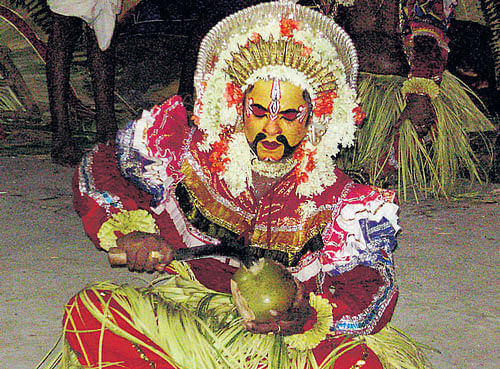
Believed to be one of the most ancient religious beliefs of coastal Karnataka, Bhoota Kola holds mirror to the customs and practices of the Tuluvas.
This annual ritual of spirit worship is practised with much fervour in Udupi and Dakshina Kannada districts in Karnataka. A night-long event, Bhoota Kola is marked with ornate costumes, make-up, music, dance, dialogues and, most of all, by the piety of those participating in this ancient form of spirit worship.
I got an opportunity to witness one such performance in a tiny hamlet named Nediyur, near Udupi. And what a spectacle it was! Spread over three nights, it was definitely worth every minute of its performance.
Protector of ‘life’
Bhoota Kola lies at the core of the village life in this region, where spirits are worshipped for generations. It starts after dusk and continues until the wee hours of the morning and people gather in large numbers to witness the performances. There is a general feeling that the bhootas protect the villagers and livestock from evil forces. These bhootas, believed to be the attendants of Lord Shiva, are considered as the conscience keepers of the community. The places where the bhootas are housed are called as bhootasthanas.
The beliefs woven around this ancient form of practice are very interesting. For instance, there are different kinds of bhootas, each claiming descent from a particular god, goddess or gana. Vishnumurthi, Ermeru, Jataadhari, Vaidyanatha, Jumadi, Brahmer, Chaundi, Siri, Panjurli, Pilichamundi, Virabhadra and Guliga are some of the bhootas that are revered. Bhootas like Kalkuda-Kallurti, Jarandaya, Kodamandaya and Babbarya are considered to be the spirits of cultural personalities.
Each bhoota is said to have a fixed sphere of influence, and is hence associated with certain families or villages. During the kola ceremony, the bhoota impersonator invokes the host family’s guardian bhoota, and answers people’s queries. Bhoota Kola season starts from November (Deepavali) and goes on until the last week of May (Pattanaje). This much awaited event draws people from far and near, who bring along with them not just their doubts and fears, but also offerings in different forms. People use this occasion to request the supernatural for a certain favour or thank for the blessings received.
The ceremonies are held in a well-decorated pandal, embellished with palm leaf and mango leaf festoons. A colourful rangoli adorns the place. The kola begins with the host ceremoniously offering coconut oil to the medium of spirit for a ritual bath. This is followed by the medium of spirit, also called patri, donning the make-up
using pastes from plant extracts.
Colourful attire
Different costumes are used to symbolise the characteristic features of the bhootas, thus making each bhoota unique in its appearance. Even as the medium of spirit is engrossed in the facial make-up, female members of his family sing the pad-danas (ballads) that narrate the story of the bhoota to be invoked, its heroic deeds and its sphere of influence.
Narrated in a sing-song manner in Tulu, the tunes of these pad-danas are quite catchy. This prepares the medium of spirit to identify himself with the particular spirit and sets the mood of the audience for the actions that follow.
At the other end of the pandal are other members of his family working with palm leaves to prepare his gown. The medium of spirit first tries on the dress, and then wears the requisite ornaments including ear and shoulder coverings, a waist piece, bangles, anklets and the headgear. The most important ornament of all is the gaggara (metal anklet), which gives a deep metallic sound. Even as he wears the gaggara, a small group of musicians start playing drums and wind instruments and the ritual dancer starts tapping his feet to the rhythm of the beats and invokes the spirit. Possession, trance and the dialogue of the medium of spirit with the devotees are the crucial stages of bhoota worship.
Feared and revered
Once he is possessed by the spirit, he jumps around, roaring with anger, and is offered tender coconuts to calm down. After downing several tender coconuts, the spirit addresses the host, wanting to know the reason behind his invocation. People pour out their woes at this juncture. He assumes the role of the spirit, listens to them patiently, and gives out suitable answers. Apart from according physical health and mental peace, the medium of spirit assumes the role of a tribunal and settles disputes, upholding truth and righteousness.
After feasting on the offerings made to him, the appeased spirit once again assures the gathering of continued protection. He then sits down exhausted after a spirited performance spanning several hours and fans himself with a chamara (hand-held fan).
People take the cue and go up to the bhoota who blesses each one of them with a touch of his sword and hands out kumkum and pingara (arecanut flower), which people take home as prasada.
I was told that this was just one chapter of Bhoota Kola as several spirits, sometimes as many as 18, are invoked in a span of just two nights. However, if you thought Bhoota Kola was only about serious worship, then you’re mistaken. For, each moment of the performance is nothing like the one you would have seen before. Moreover, there are many light moments too, when some bhootas are accompanied by sidekicks, who double up as clowns, dancing vigorously, moving comically and cracking jokes to no end.That was my heartening experience of the kola, which enlightened me about another fascinating facet of our ancient culture. I returned home as the sound of the drum reverberated in my mind.